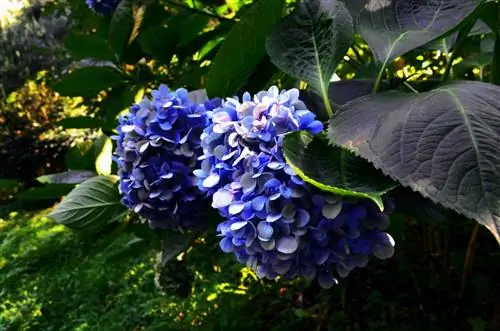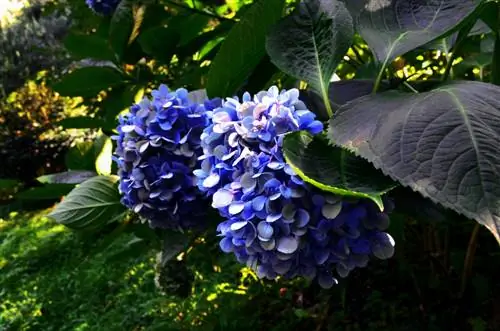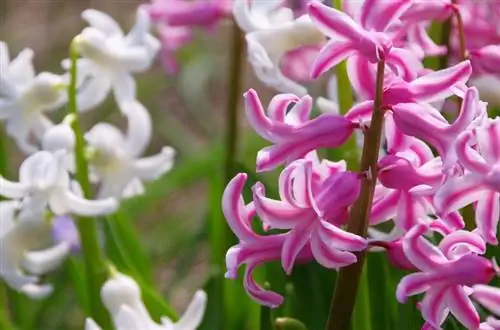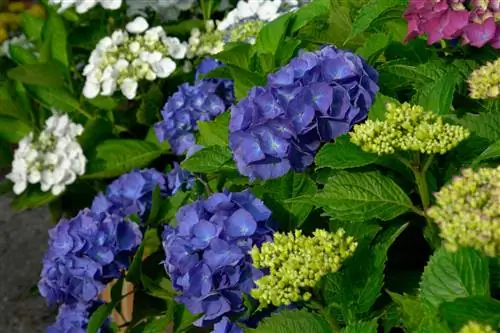- Author admin [email protected].
- Public 2023-12-25 17:45.
- Last modified 2025-01-23 11:21.
Garden hydrangeas are real flower miracles. Their bright colors enchant every viewer. But the splendor of colors does not come by itself. There are a few factors you need to consider when caring for and choosing the location so that the subshrub grows vigorously.

What conditions does the garden hydrangea need for optimal growth?
The garden hydrangea (Hydrangea macrophylla) is a popular subshrub with magnificent flowers. It prefers partially shaded, protected locations, humus-rich and moist soils as well as regular fertilization and irrigation. Popular varieties include Endless Summer, Forever & Ever, Alpenglühen and Hovaria Hobella.
Origin
The garden hydrangea is known as the farmer's hydrangea. Its Latin name is Hydrangea macrophylla. It is considered the best-known representative within the hydrangea genus, as its triumphal march through the gardens of Europe began in the early 20th century. During this era, numerous breedings and hybrids emerged. Before that, the plant was cultivated in its original distribution area in Japan.
leaves
Garden hydrangeas develop oppositely arranged leaves that are composed of a petiole and a leaf blade. The stems are short and appear fleshy. They end in a simply constructed blade. It has a sharply toothed leaf edge and is crossed by a raised central nerve from which numerous lateral nerves branch off.
The oval to egg-shaped leaves are slightly wider or narrower depending on the variety. They can grow up to 15 centimeters long. The base of the leaf blade is bluntly wedge-shaped. The end of the leaf is pointed. The deciduous leaves are colored dark green. The top of the leaf is shiny.
Bloom
The bushes develop numerous individual flowers that cluster together to form umbrella-like inflorescences. They sit on thick branches. The outer edge of an inflorescence is covered with sterile flowers that perform a display function. The outer flowers consist of four sepals, which are strikingly large and brightly colored.
The color of the sepals varies depending on the pH of the soil. If garden hydrangeas grow on acidic soil, they develop a blue color. Alkaline soils result in red flower color. The intensity of the color varies depending on the variety. Some specimens bloom pure white. When the flowering period comes to an end, a fascinating play of colors occurs. The colors change to green and finally to rust red. This phenomenon is particularly pronounced in the new Hovaria varieties.
Inside there are fertile flowers that are responsible for reproduction. Its calyx is small and bell-shaped. The individual sepals are short and triangular in shape. In Japan, garden hydrangeas bloom between June and August. The flowering period of the plants cultivated in Central Europe extends throughout the summer and extends into October. The flower buds are formed the previous year.
Growth
The wild form of the garden hydrangea grows as a subshrub. The old shoots become woody in the second year, while the fresh shoots are herbaceous. They are deciduous and grow upright with dense branches. After flowering, the inflorescences remain on the plants.
The bark of young branches is greenish in color. As it ages it becomes brownish. Strong branches appear light brown. They are covered by a felty bark that can be easily removed.
Size
Garden hydrangeas reach heights of up to two meters in their original distribution area. Depending on the variety and location conditions, the heights vary. The summer bloomers require a lot of space, which depends on their height. Garden hydrangeas grow at least as wide as they are tall.
Usage
The summer shrubs have a rustic character. They are suitable for planting in perennial beds that ensure semi-shady conditions. The summer bloomers cut a particularly good figure among higher-growing trees. They beautify small front gardens and bring colorful accents into dark corners of the garden.
Other types of hydrangeas prove to be ideal planting partners. They can be planted in small groups and rows, creating a dense hedge over time. Garden hydrangeas feel comfortable next to rhododendrons and other plants in shady to semi-shady locations. The floral splendor comes into its own perfectly between hostas, star umbels, forest goat's beard or astilbe.
Is garden hydrangea poisonous?
Like all hydrangea plants, garden hydrangeas contain various toxins. They are weakly concentrated in all parts of the plant. In addition to hydrogen cyanide, hydrangenol, saponins and hydrangin occur. Poisoning does not normally occur after consuming small amounts. Only large quantities cause symptoms of poisoning. Sensitive people may have an allergic reaction to skin contact.
Possible symptoms:
- feeling of oppression
- Circulation problems and dizziness
- Shortness of breath
- Cramps
Hardenseas are slightly poisonous to horses, dogs and cats, birds, rabbits, hamsters and guinea pigs. The toxins can lead to circulatory problems or gastrointestinal problems. Serious symptoms of poisoning only occur after consuming large quantities. The bitter taste of the plant often deters animals.
Which location is suitable?
Farmer hydrangeas have special location requirements. They originally grow along watercourses and moist forest edges. The subshrubs prefer a sheltered place with partially shaded conditions. A north or west facing location where there is no draft is ideal. The plants also grow under strong sunlight. Under these conditions, the need for water increases sharply. When there is a lack of water, the garden hydrangea lets its leaves droop and gets sunburnt.read more
What soil does the plant need?
The substrate should be low in lime, rich in humus and moist. A pH value between 4.5 and 6 is ideal. At a low pH value, the subshrub flowers blue. Higher values produce purple, pink or red tones. White-flowering varieties do not change their flower color.
Propagate garden hydrangea
The simplest method is propagation from cuttings. Cut off fresh shoots in July. Make sure that the shoots do not have any flower buds. Divide the shoots into small sections, each with two pairs of leaves. The bottom pair of leaves is removed and the top leaves are shortened by half. This means that the cuttings have more space to spread out in the planter and can put more energy into root development.
Place the cut shoots in potting soil and water the substrate. To maintain humidity, you should place a plastic bag or screw-top jar over the planter. Ventilate daily to prevent mold from forming. Place the planter in a warm and shady place in the garden or on the terrace. The cuttings require little time for root development.
Pricking
When the cuttings have developed roots, they are pricked out and transplanted individually into small pots. The planter should have a diameter of ten centimeters. Place the pot in a shady place. You no longer need to cover the young plants with foil for further cultivation. In the first winter, the young plants are sensitive to frosty temperatures. Place the planter in a cool, frost-free place in the house. By next spring the plants will have developed to the point where they are ready to be planted out in the garden.
Sowing
Propagation via seeds is difficult. Many double varieties do not develop seeds. Original varieties and the wild species carry seeds inside the withered inflorescences. They are difficult to collect because they are very hidden and, at three millimeters long, are hardly noticeable. You can buy seeds in specialist shops.
How to sow the seeds:
- Fill the planter with potting soil
- Spread seeds
- cover lightly with soil
- moisten with a spray bottle
- Cover the plant pot with foil
Garden hydrangea in pot
Garden hydrangeas are ideal for container cultivation. They beautify balconies, house entrances and terraces. Potted hydrangeas are often available in stores. This term is misleading because it is not a separate species. Potted hydrangeas are also varieties of Hydrangea macrophylla.
In the greenhouse
A greenhouse provides optimal conditions for growing garden hydrangeas. Potted hydrangeas, which are already in full bloom between February and April, were grown in the greenhouse. These specimens are sensitive to late frosts and require winter protection. Hydrangeas grown in the greenhouse should not be planted in the garden in the first year. They are initially very sensitive to cold.
Cut garden hydrangea correctly
Farmer hydrangeas do not need to be cut. In spring you should remove the withered inflorescences so that the fresh buds can develop unhindered. Cut back dead and frozen branches. You can recognize these by the gray-brown discoloration. If you are unsure, you can lightly scratch the bark. If the tissue underneath is yellow-green and appears dry, then the shoot has died.
Apply carefully when thinning. Most varieties develop their flower buds in the fall. Pruning measures in spring reduce the number of flowers. There are special varieties that develop new flowers even after vigorous pruning.read more
Fertilize your garden hydrangea properly
Garden hydrangeas enjoy a special fertilizer (€8.00 on Amazon) for hydrangeas or rhododendrons. To promote blue coloring, the fertilizer should contain alum. This aluminum s alt contains water-soluble crystals that have an acidic effect.
Free-growing hydrangeas are fertilized for the first time in spring. A second fertilization takes place in early summer. Use a slow-release fertilizer that the plant feeds on throughout the entire growing season. Potted plants are supplied with a liquid fertilizer at regular intervals between March and August. Stop fertilizing as soon as summer comes to an end. Then the fresh shoots have enough time to become woody. The shoot tips remain unwoody, which is typical for subshrubs.
Watering the garden hydrangea
The subshrubs have a high water requirement. If there is direct sunlight at the place of growth, the plants require larger amounts of water. Water the plants thoroughly so that the soil is well moistened. The root ball should never dry out completely. Check the substrate more frequently in hot summer months to avoid drying out. Plants grown in pots should be watered twice a day in summer.
Do not use hard water for watering as this changes the pH value in the substrate. Use soft rainwater. Tap water can be treated with a dash of vinegar. Avoid waterlogging as this damages the roots of the hydrangea.
Wintering
Potted hydrangeas should overwinter indoors in cold winter regions. An unheated greenhouse is the ideal location if it is protected from direct winter sun. This means that the temperature fluctuations are lower. Dark overwintering is possible. Pay attention to low temperatures that do not rise above five degrees. Under these conditions, the garden hydrangeas stop their metabolism. Bright and warm winters are suboptimal because the shrubs are quickly attacked by pests. The lack of rest time inhibits the development of new flower buds.
Specimens growing outdoors require additional winter protection when young. A layer of pine branches or brushwood is ideal. Older plants do not need winter protection in regions with mild winters. Protect the plant during severe frosts.read more
Fungal infestation
Hydrangea species can be affected by both powdery mildew and downy mildew. Powdery mildew is a fungus that spreads in dry and warm weather conditions. You can recognize an infestation by the white coating, which is reminiscent of a layer of flour. Downy mildew needs moisture. It leaves a silvery-gray fungal lawn on the underside of the leaves.
How to combat mildew:
- cut off and destroy affected areas
- Remedies with neem extract or silica help against powdery mildew
- Garlic or onion broth combats downy mildew
Brown spots on the leaves indicate leaf spot disease. It occurs when there is poor nutrient supply. Just like this fungus, gray mold also spreads in damp weather conditions. An infestation can be recognized by the gray grass that stretches over flowers, leaves and shoots. The plant parts will wither if the plant is not treated. Optimal care with a good supply of nutrients and water helps prevent these fungal diseases. The plants should be well ventilated.
Diseases
Chlorosis is a relatively common disease that manifests itself in a green discoloration of the leaf veins. The leaves turn yellow over time. Chlorosis is due to iron deficiency. An alkaline soil can also lead to this disease. Work rhododendron soil or peat into the soil to lower the pH. A fertilizer containing iron provides a quick remedy.
Certain mycoplasmas or viruses cause virosis in garden hydrangeas. Diseased plants have small and stunted inflorescences. The plant parts take on reddish hues. Since this disease can quickly spread to other plants and cannot be controlled, you must quickly remove the affected plant and burn it if possible.
Tip
Support the inflorescences of large-flowered varieties with a curved perennial holder, as their stems can easily bend, especially after heavy rain and in windy conditions. Remove broken shoots. The plant usually regenerates quickly.
Varieties
- Endless Summer: For sunny locations. Very easy to cut. Blooms reliably after pruning in spring. Particularly hardy.
- Forever & Ever: For sunny locations. Good cutting tolerance. Blooms reliably after early pruning. Flowering occurs twice a year. Easy to care for.
- Alpenglow: For locations exposed to wind. Fast growing. Blooms crimson red between July and September. Foliage dark green. Growth height 120 to 150 centimeters.
- Hovaria Hobella: Blooms in pastel pink tones, flowers up to 25 centimeters large. Flowers turn green and red. Grows between 100 and 150 centimeters high.
- Hovaria Love you kiss: Blooms white with red serrated edges between June and October, flowering lasts four to six weeks, then flowers turn green and red. Reaches heights between 100 and 150 centimeters.






